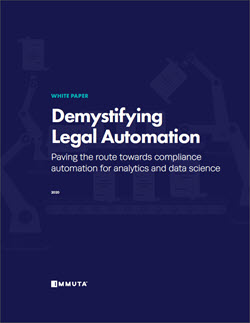
Demystifying Legal Automation
July 27, 2020
Legal automation is usually seen with suspicion by lawyers and others. This is because substituting the law enforcement process with a technological or self-executing enforcement process is inherently problematic as opacity inevitably creeps in. Who is in charge? Who is answerable? Who could be held liable if something goes wrong?
Not all forms of legal automation are substitutive, however. Legal automation is supportive when it aims to reduce human intervention and ensure that a human with relevant legal expertise is properly informed or equipped for decision making—and remains both in charge and answerable.
Such an approach is particularly useful in the field of compliance.
We thus introduce the concept of compliance automation and define it as an approach that aims to reduce human intervention while ensuring that a human with relevant legal expertise is in charge and is able to make executable, traceable, and contestable decisions.
This whitepaper is organized into three main sections:
- Concepts of substitutive and supportive legal automation
- What problems compliance automation can solve
- Recommendations for building and scaling automated policies